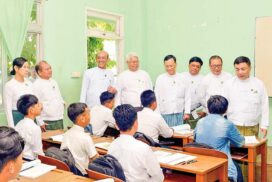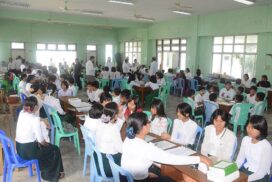Citizens of Myanmar started their learning at monastic education under the management of Buddhist monks. Parents and guardians sent their offspring to monastic schools for learning literature and Buddhism as well as public ethics lectured by members of the Sangha.
During the period from 1962 to 1988, monastic education schools and private schools were closed for various reasons. But monastic education schools were allowed to reopen in 1992 to run them under the curriculum adopted by the Ministry of Education.
Those monastic education schools approved by the 2014 national education law are under the joint management of the Ministry of Religious Affairs and Culture and the Ministry of Education.
In the 2020-21 academic year, 1,489 monastic education schools including 797 primary schools, 589 post-primary schools, 101 middle schools and 26 high schools were allowed to be opened in regions and states including those from the Nay Pyi Taw Council Area under the supervision of the monastic education supervisory central committee.
The number of students at the monastic education schools in the Mandalay Region was top on the chart, followed by those from Yangon and Sagaing regions. These schools restrict the disciplines and morals of the students but face weakness as a lesser contribution to the academic measures depending on the donated cash.
Moreover, teachers from monastic education schools did not have recognition for their qualifications and capacity. However, monastic education schools have been contributing much to Myanmar’s education system in successive eras. Hence, it is necessary to assist these schools.
As of the 2021-22 academic year, monthly cash assistance for primary assistance teachers was extended to K57,000, up from K43,000, for post-primary and junior assistance teacher K64,500, up from K43,000, and senior assistant teacher K70,500, up from K47,000 per month.
The government arranges refresher courses, child-centred teaching and administration for the teachers from the monastic education schools. Monastic education schools create learning opportunities for school-age children from both urban and rural areas to pursue education in accord with the theme: ‘to attend schools for every school-age child’ while preserving the traditions and customs without opposing the education policy of the Ministry of Education.
Buddhist monks have been playing a key role in the education sector of Myanmar in successive eras. It is because those who learned education in the monastic education led the various sectors of the country including politics, economic, military and social affairs until today.
Maintain traditions of running monastic education
- March 19, 2022
- 1431














